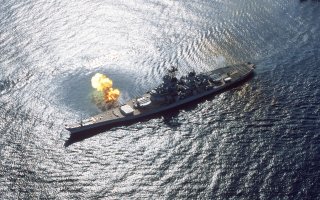This Picture Explains Why the Iowa-Class Battleship Was Unstoppable
Designed to intercept fast capital ships yet still capable of serving in a traditional battle alongside other U.S. Navy warships, the Iowa-class battleship successfully combined speed and firepower.
Designed to intercept fast capital ships yet still capable of serving in a traditional battle alongside other U.S. Navy warships, the Iowa-class battleship successfully combined speed and firepower.
Unlike slower battleships, the class was constructed to travel with a carrier force – and even built to be able to transit the Panama Canal, which enabled the warships to respond to threats around the world.
Iowa-class Battleship: Origin Story
The largest and most powerful battleships built for the U.S. Navy, the Iowa-class were also the final battleships that entered service.
Well before the Japanese attack on Pearl Harbor, the U.S. Navy saw that the clouds of war were on the horizon and that there would be a need for a "fast battleship" that could take on the increasing might of the Imperial Japanese Navy.
Part of a new breed of American warships, six of the fast capital ships was ordered, while four were eventually constructed– including the lead ship of her class, USS Iowa (BB-61) along with sister ships USS New Jersey (BB-62), USS Missouri (BB-63) and USS Wisconsin (BB-64). Two additional ships, planned Illinois (BB-65) and Kentucky (BB66), were laid but canceled with both hulls scrapped at the end of the war.
While speedy warships, also notable was the speed in which the four were completed. Iowa was laid down on June 6, 1940, and competed on February 22, 1943 – while the New Jersey was actually launched on December 7, 1942, just a year after the sneak attack on Pearl Harbor and completed on May 23, 1943. Even as the war highlighted the potential of aircraft carriers over the massive battle wagons, the battleships played a crucial role in the Pacific "island-hopping" campaign.
One Tough Battleship
Armed with a main battery of 16-inch guns that could hit targets nearly 24 miles away with a variety of artillery shells, the Iowa-class were among the most heavily armed U.S. military ships ever put to sea. The battleships' main battery consisted of nine 16"/50 caliber Mark 7 guns in three-gun turrets, which could fire 2,700-pound (1,225 kg) armor-piercing shells some 23 miles (42.6 km). Secondary batteries consisted of twenty 5"/38 caliber guns mounted in twin-gun dual-purpose (DP) turrets, which could hit targets up to 9 miles (16.7 km) away.
Initially equipped with 40mm anti-aircraft guns, during the Cold War those were replaced with missiles, electronic-warfare suites and Phalanx anti-missile Gatling gun systems.
How the Iowa-class Battleships Made History
It was aboard the USS Missouri in September 1945 that the representatives from the Empire of Japan officially surrendered and ended World War II.
That could have been the end for the warships, and by the outbreak of the Korean War, only the USS Missouri remained on active duty. However, her three sisters were reactivated and provided naval gunfire support during the war. While the range of the 16-inch guns was limited to just 20 miles, the warships operated on both coasts doing tremendous damage to North Korean positions.
Following the war, all four ships were decommissioned – although USS New Jersey was briefly called up again during the Vietnam War.
Then in the 1980s when President Ronald Reagan called for a 600-ship U.S. Navy, all four of the ships were reactivated and upgraded with new combat systems that replaced many of the ships' smaller five-inch guns with a launcher for Harpoon anti-ship missiles, 32 Tomahawk cruise missiles, and four Phalanx close-in weapon systems (CIWS).
It was a brief respite for the Iowa-class battleships, and both the lead warship and her sister New Jersey were in the process of being decommissioned when Missouri and Wisconsin were deployed to the Persian Gulf and took part in Operation Desert Storm. The two World War II battle wagons launched Tomahawk missiles at Iraqi targets. The naval fire missions were conducted to convince the Iraqi Army that the coalition forces would engage with an amphibious assault, tying up thousands of Iraqi units in Kuwait.
It was the last hurrah for the Iowa-class and marked the last time they'd fire their weapons in anger. Less than two years later in 1992, the sun finally set on the "age of the battleship," and all four of the Navy's largest vessels were converted to museum ships at Pearl Harbor, Hawaii (USS Missouri); Los Angeles, California (USS Iowa); Norfolk, Virginia (USS Wisconsin); and Camden, New Jersey (USS New Jersey).
While converted into museums, yet otherwise not altered in any way that would impair their respective military ability, was because theoretically each could be reactivated for service if the need came. While it has been nearly 20 years, there have been calls for the venerable warships to return to the sea, but for now, their job is simply to help preserve the memories of the sacrifices made by those who served and to highlight the history of the American battleship.
Peter Suciu is a Michigan-based writer who has contributed to more than four dozen magazines, newspapers and websites. He regularly writes about military small arms, and is the author of several books on military headgear including A Gallery of Military Headdress, which is available on Amazon.com.


